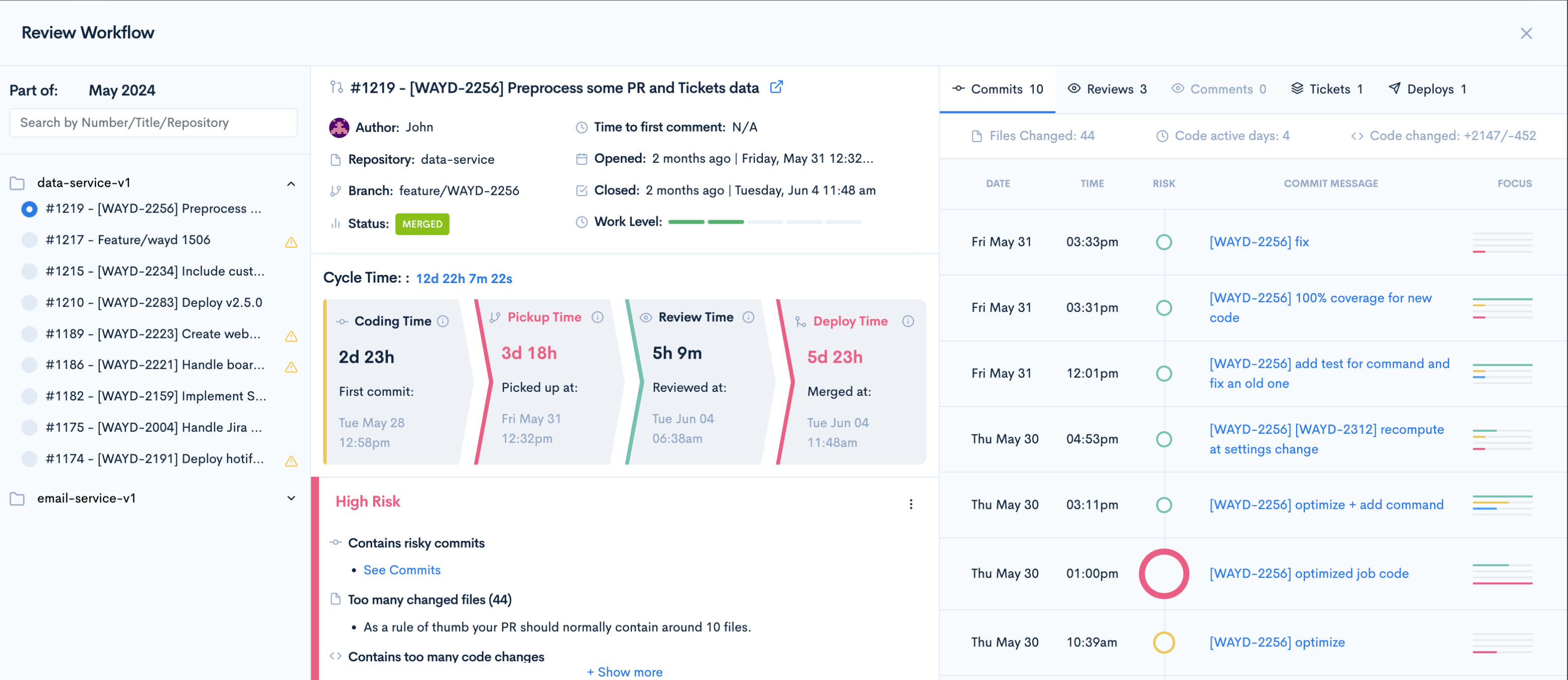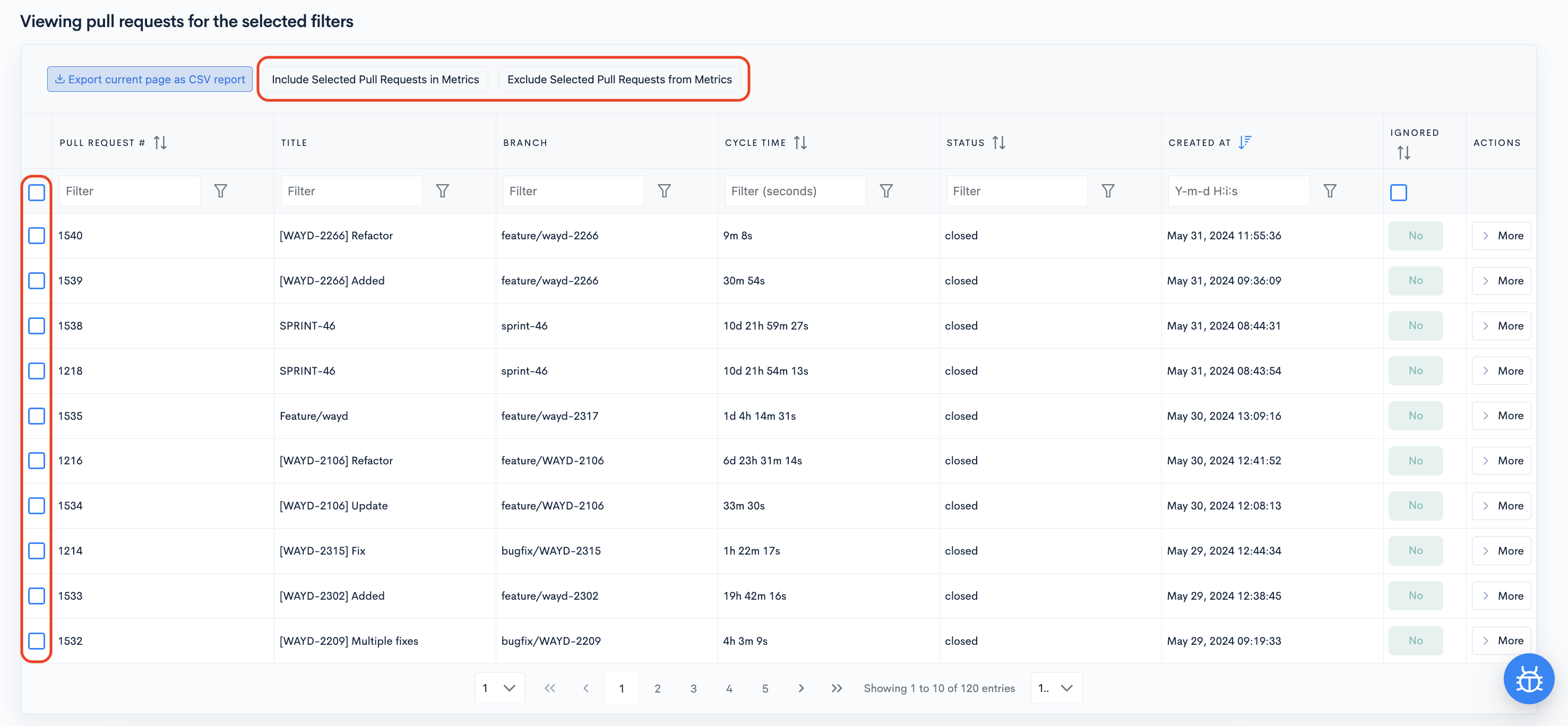Cycle Time
The Cycle Time metric is an indicator of an organization's development velocity.
Cycle Time indicates an organization's development velocity. It is the sum of four metrics, each corresponding to a stage in the software development process:

Metric Breakdown
CODING - Time to Issue PR from First Commit. This metric represents the coding time, measuring the elapsed time from the first commit to the creation of a Pull Request (PR).
PICKUP - Time to First Review. This metric indicates how quickly reviewers pick up their peers' PRs. It measures the time between when a PR is opened and the first review by an engineer.
REVIEW - Time to Merge from First Review. This metric signifies how fast submitters incorporate feedback from their peers during code review. It measures the time from a PR's first review to its merge.
DEPLOY - Time to Deploy from Merge. This metric indicates how quickly code is deployed into production. It measures the time between when a PR is merged and when it is released into production.
What do the colors indicate?
We have aggregated benchmark values from our platform for each stage of the cycle time. Green bars indicate leading values, yellow bars represent average values, and red bars signify below-average values.
-
For CODING:
Green: Less than 48 hours
Yellow: Between 48 and 72 hours
Red: More than 72 hours
-
For PICKUP:
Green: Less than 24 hours
Yellow: Between 24 and 72 hours
Red: More than 72 hours
-
For REVIEW:
Green: Less than 24 hours
Yellow: Between 24 and 72 hours
Red: More than 72 hours
-
For DEPLOY:
Green: Less than 10 hours
Yellow: Between 10 and 24 hours
Red: More than 24 hours
Pull Request Breakdown
Scroll down to view the Pull Request breakdown for all PRs analyzed within the selected time frame. Expand a Pull Request to access more data, such as associated commits, deploys, issues, and reviews, along with the Pull Request's Lead Time. You also have the option to ignore a PR so that it will not impact the Cycle Time.
On the right side of each PR, a "More" button is available. Clicking this button expands the PR and reveals a modal containing additional information.

PR Modal

- Grouped PRs: On the left, all PRs from that category are grouped by repository.
- Branch: The branch associated with the PR.
- Status: The current status of the PR.
- Time to First Comment: The time elapsed until the first comment.
- Open/Closed Dates: The dates when the PR was opened and closed.
- Work Level: Bars fill based on the difficulty level.
- Cycle Time: The Cycle Time specific to this PR.
- Risk: High/Medium/Low.
- Description: The PR's description (follow best practices).
- Commits: Commits linked to the PR, including an overview and a direct link.
- Reviews: A list of reviewers.
- Comments: All comments made on the PR.
- Tickets: Any tickets linked to the PR.
- Deploys: Information regarding deploys.
When expanding specific commits, the modal also includes a "Go to commit" button, which directs you to the commit page in the Git Provider.

Ignore Pull Requests
You have two options to ignore a Pull Request from the Cycle Time calculation:
-
Exclude PRs from the list by selecting one or more PRs and then clicking Exclude Selected Pull Requests from Metrics.
 To re-include PRs in the calculation, select them from the list and click Include Selected Pull Requests in Metrics.
To re-include PRs in the calculation, select them from the list and click Include Selected Pull Requests in Metrics. -
Clicking "More" to open the modal provides the option to Ignore the Pull Request by clicking the three-dot menu within the Risk section.

Updated 4 months ago